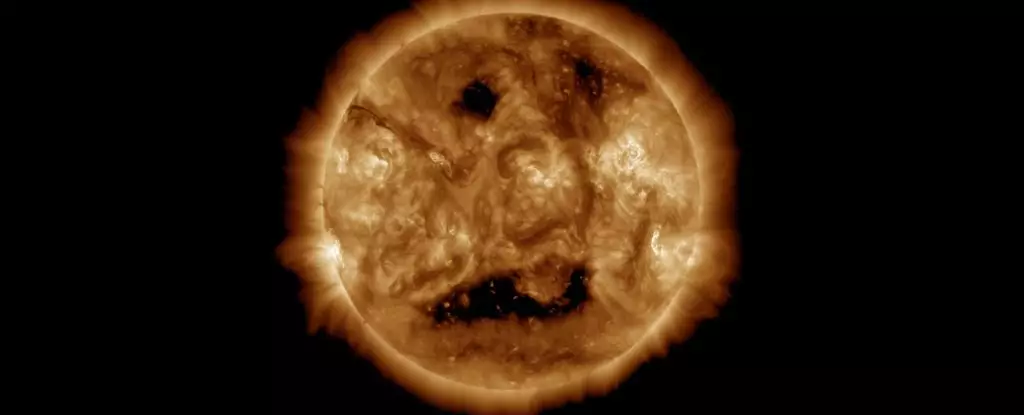Our Sun, a majestic celestial body, constantly displays a stunning array of phenomena, with coronal holes standing out as one of the most fascinating. These aren’t actual gaps in the solar surface but are rather areas where the Sun’s magnetic field opens up, similar to an inlet allowing sea water to rush into a calm bay. These coronal holes can send streams of charged particles racing into space, expanding the Sun’s influence throughout the Solar System. The current coronal hole is immense, comparable to the size of five Jupiters, and is directing a wave of solar wind toward Earth.
While observing the Sun’s surface in optical wavelengths provides little to no indication of these coronal holes, they reveal their presence through ultraviolet imaging. Here, they manifest as dark patches against the brighter, denser plasma surrounding them. Such visual representations create a peculiar and intriguing picture of the Sun’s magnetic complexities. As if giving a cosmic expression, the Sun’s coronal hole configuration resembles a face, complete with a gaping mouth in the southern hemisphere and two prominent ‘eyes’ in the north, reinforcing the notion that the Sun is an animated character in our cosmic drama.
Understanding Solar Winds and Earth’s Magnetosphere
Though the concept of the Sun “breathing” solar winds might sound whimsical, the dynamics are rigorously scientific. Solar winds, a continuous flow of charged particles from the Sun, can have significant interactions with Earth’s magnetosphere. Coronal holes are among the sources of these winds and are essential for understanding solar activity’s impact on Earth. When particles from these coronal regions collide with our magnetosphere, they can generate geomagnetic storms.
However, apprehension regarding the potential effects of solar wind is often overstated. The current coronal outflow isn’t expected to produce major disruptions. The British Met Office suggests that while there might be a minor enhancement in solar wind speeds from the southern coronal hole, the likelihood of a significant geomagnetic storm is low. History has shown that more intense geomagnetic storms arise from coronal mass ejections (CMEs), which are far more potent eruptions of solar material than those caused by coronal holes.
Current Solar Activities: A Mixed Bag of Beauty and Chaos
What’s truly captivating is that our Sun is currently in an active phase of its solar cycle, showcasing remarkable intensity in its eruptions. The recent G4 geomagnetic storm bathed parts of the Earth in stunning auroras, which paint the night sky in vibrant colors, transforming mundane landscapes into surreal vistas. For many, these celestial displays symbolize the beauty and mystery of the universe, transcending the scientific explanations surrounding them.
Given that we are transitioning out of one of the most vigorous solar cycles in recent history, it should come as no surprise that unusual solar behavior continues to unfold. Each flare and coronal hole holds the potential for unexpected events. It’s a much-welcomed reminder of how dynamic our solar environment can be, and how the effects can reach distant corners of our planet. However, as awe-inspiring as these events are, they also serve as a stark reminder of the delicate dance between Earth and the Sun.
The Duality of Solar Phenomena: Impact and Inspiration
Although solar activity can induce fascinating phenomena like the Northern and Southern Lights, it also poses risks that humanity must consider. Understanding these phenomena is crucial for flight safety, satellite operations, and even power grid management on Earth. For space agencies and scientists, monitoring the Sun’s behavior has become increasingly important, especially as we rely more on technology that can be disrupted by cosmic activities.
Despite any potential threats posed by solar events, there’s an undeniable allure in observing and studying them. They offer humanity a front-row seat to the immense forces at play in our universe. The Sun, with its vastness and unpredictability, evokes a sense of humility and respect. It remains a powerful reminder of our small place within the cosmos—yet it also offers an inspirational view into the dynamic processes that shape our solar system.
With every coronal hole and solar flare, we uncover more about the Sun’s complex behaviors and their effects on our planet. In a world filled with uncertainties, perhaps it’s comforting to know that the Sun continues to express itself uniquely, just as we humans do—sometimes alarming, often stunning, but always majestic.

